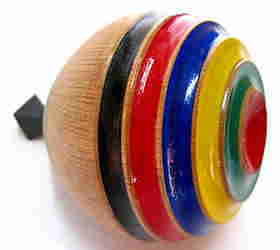|
A
spinning top is a traditional toy played with during the New Year holidays.
The term
of gspinning toph represents winterh, or gJanuary-in Haiku, the verse form
consisting of-17 syllables in a 5-7-5 line pattern.![C:\Users\FMV\AppData\Local\Microsoft\Windows\Temporary Internet Files\Content.IE5\V2DARSCW\MC900223020[1].wmf](clip_image002.gif)
The simple shapes and beautiful harmony of colors is what attracts us to
spinning tops,a traditional Japanese game toy. It is also fun to play with.
The top is more than a toy in Japan.The top
is not only a folk craft used as a toy, but also a traditional art perfected by
the Japanese. Top-spinning performances are enjoyed by young and old alike.
As a
kind of pun, the elegantly spinning motion of the toy symbolizes gcirculation
of moneyh hsmooth workh, and gbeing quick-wittedh.
@Historically, it was in the Nara period that tops came into existence
in Japan. It is said that they came to Japan through the Korean Peninsula-,
or perhaps appeared spontaneously in Japan. It is said that fortune-tellers
called gkoma-byoushih told fortunes by circulating spinning tops in ceremonies
held by the court.
 Tops popular in the Edo period traditionally had five colors. Each of them
has its own meaning; red represents health , black; power ,yellow; wealth,
green; harvest, and purple; nobility. Tops popular in the Edo period traditionally had five colors. Each of them
has its own meaning; red represents health , black; power ,yellow; wealth,
green; harvest, and purple; nobility.
@There are many kinds of tops in Japan. They vary in color, shape, and size,
depending on the region they come from; they all have unique characteristics.
@Especially, lucky spinning tops are in every region of the country. hkazarigomah,
or (decoration top) are, for example-, used as a gift for gthe celebration
of a new house builth or, as in YameCity, Fukuoka Prefecture, hthe celebration
of wedding.h In the Kansai area, tops are buried in the pillars of a house
when it is built in hopes of bringing prosperity to the family.
Tops have been highly prized as a symbol of good luck in Japan.
For further information,
Refer to
the link shown below;
gNihon
Koma Hakubutsukanh********************************************************************************References:
Trad-Japan
WikipediaKoujien
|
![C:\Users\FMV\AppData\Local\Microsoft\Windows\Temporary Internet Files\Content.IE5\V2DARSCW\MC900223020[1].wmf](clip_image002.gif)
